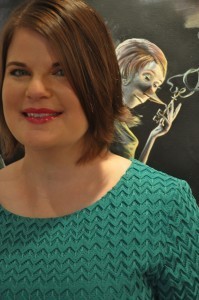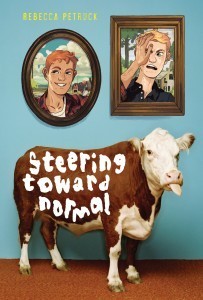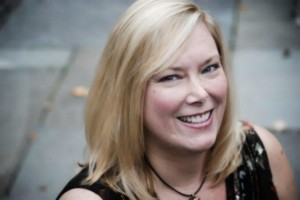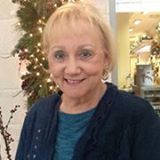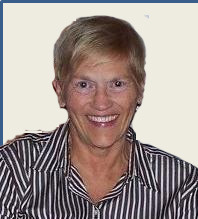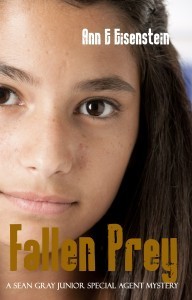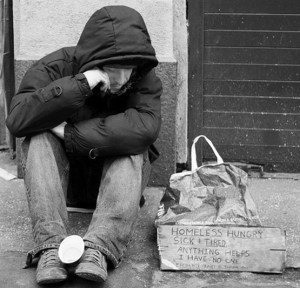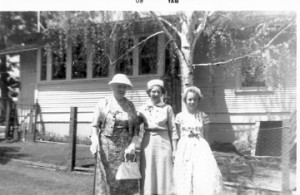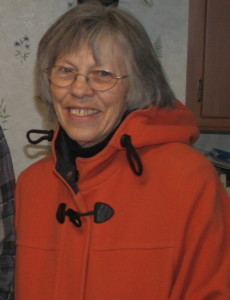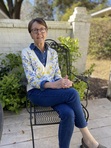Linda Vigen Phillips's Blog, page 9
January 20, 2014
Featuring Rebecca Petruck’s Steering Toward Normal (and a chance to win it!)
In my ongoing series featuring fellow 2014 debut authors, I am delighted to have Rebecca Petruck with me today to talk about her forthcoming book, Steering Toward Normal, being released by Abrams/Amulet on May 13, 2014.
WHO is your protagonist?
Diggy Lawson is a good kid who likes to think he’s pretty tough, but is a total softie—and would tackle me for saying so. He raises steers to compete at county and state fairs, and is really good at it because raising steers is all heart, and Diggy has a big one. But he’s definitely tested when a half-brother turns up that makes Diggy question a lot about himself, his relationship with Pop, and how he’s supposed to feel about the new kid.
WHAT do you love writing about?
I love to learn a lot about offbeat or overlooked interests like raising competitive steers or entomophagy (the eating of insects for nutrition). I think when a lot of people think of beef cattle, they think of feed lots, and that definitely is where most of their beef comes from. But there’s this vibrant, generous subculture of steer competitors who work their butts off doing something that will only end in the heartbreak of watching their animals loaded onto the packer’s truck. That’s practically the definition of drama.
WHERE is your book set?
I was born in Minnesota. We moved away when I was eight, but all my mom’s family is there—grandparents, great aunts and uncles, regular aunts and uncles, and a ton of cousins. No matter where I’ve lived, Minnesota has always felt like home base. So even though I didn’t have a plan to set STEERING TOWARD NORMAL in Minnesota—honestly, I thought North Carolina would be easier because it’s where I live now—the boys always ended up in a house next to a cornfield with a turkey hangar just up the road. There is something I can’t resist about those long gravel roads and seeming isolation of the country that isn’t really isolated at all because everyone knows everything all the time.
WHEN do you write best?
When I’ve had time to interview people, visit places, research a topic, and mull. Many of my best scenes have come from random asides and chance spottings. But I don’t let myself get lost in the research spiral of happy doom. I COULD, easily and happily, but I’m kind of a peasant. I don’t feel good unless I’ve produced something, so I’ll often write before I know what I’m doing and let that guide further research.
WHY did you decide to write about your book topic?
I really wanted to write about a fairly ordinary, good kid who’s just trying to cope with a crappy situation in the best way he can. Generally, I think most kids are pretty good, trying to cope, trying to be good people in the world, and I wanted to acknowledge that. We hear the horror stories in the news, and that awareness is important, but those kids aren’t the average kid. I think most students today are interested and interesting, generous, kind, willing to help each other, willing to stand up for each other—I’ve seen it in my cousins and in my friends’ children, the students I’ve interviewed and the ones I mentor. Those kids don’t always get a book because the drama of being a decent person isn’t obvious. But it is real and very dramatic because every day they are making a choice to be decent people, no matter how they are tested. I think that’s incredibly brave. Throw in a couple of steers and it’s both brave and funny.
Steering Toward Normal will be released by Abrams/Amulet May 2014. For more information, visit Rebecca Petruck’s web site at www.rebeccapetruck.com or follow her on Twitter @RebeccaPetruck. AND, Abrams/Amulet is hosting a ten-ARC giveaway on Goodreads at http://bit.ly/19ZhjqT right now!
******************
Hey READERS, I would love to hear from you.
Is your MIND FULL of old thoughts or new?
January 13, 2014
Featuring Madeleine Kuderick’s YA novel, Kiss of Broken Glass
For the next little while I will be featuring fellow 2014 debut authors with a wide-open Who, What, Where, When, Why format. Today I welcome Madeleine Kuderick, whose YA novel Kiss of Broken Glass will be released by Harper Teen in September 2014.
Who am I: I’m a YA author and poet who grew up in Oak Park, Illinois, near Chicago. In high school, I was editor-in-chief of the same newspaper that Ernest Hemingway wrote for as a teen. I studied journalism at Indiana University before transferring to the School of Hard Knocks where I earned plenty of bumps and bruises and eventually an MBA. KISS OF BROKEN GLASS is my debut novel.
What do I like writing about: I like writing about underdogs. Even the ones who snarl and don’t want to be rescued. Because let’s face it, underdogs are a lot more interesting than those fluffy pedigrees with pom-poms and perfect teeth.
Where is my book set: My novel is set in a psych ward where my protagonist is locked up for 72 hours after she’s caught cutting in the school bathroom. This is what she has to say about the place:
I bet you wonder how anyone could ever change
in just three days,
in a place like this,
where everybody’s broken.
Trust me.
I wonder that myself.
Where do I get my ideas: I usually get my ideas from personal experiences. Things that touch my life. Something someone says. A single sentence can explode into an entire story line. I’m also a big fan of street art which I’m currently collecting on my Tumblr. Lots of inspiration there.
Where am I going personally: I could say I’m going crazy, or over the edge, or around and around with anticipation because waiting for your first book to come out feels like all those things. But as far as an actual place I’d have to say I’m going OVER THE MOON. Isn’t that where all debut authors go?
When do I write best: After midnight.
Why do I think I’ll succeed in this crazy business: Because I write with all my heart, have plenty of persistence, and require very little sleep. Seriously though, I think it’s all about how you measure success. If my book touches even one person, shines some light in a dark place, gives that person a little hope – well then, that would be success to me.
KISS OF BROKEN GLASS is coming September 2014 from HarperTeen. For more information, check out Madeleine’s website at www.madeleinekuderick.com or follow her on Twitter @kuderickwrites.
******************
Hey READERS, I would love to hear from you.
Is your MIND FULL of old thoughts or new?
January 6, 2014
The Role of the School Counselor
Congratulations to Laura Sells for winning last week’s drawing of Ann Eisenstein’s book, Fallen Prey!
I spend a lot of time reading YA and Middle Grade books, and on more than one occasion I’ve wondered how the protagonist’s life might have gone (how the story might have been different) with the intervention of a school counselor. In some cases, such as Jack Gantos’s Joey Pigza books, the counselor plays a major role.
I sat down with a good friend and retired school counselor, Rita Griffin, recently to talk about the role of school counselor today. Rita has an M. Ed. from UNCC in addition to school administration and counselor certification. Her career included stints at Morningside Academy, an alternative high school, Marie G. Davis, an IB/Communication Arts choice school and most recently, at South Charlotte Middle School.
LP: Rita, what motivated you to become a school counselor?
RG: After teaching for ten years and then working in administration for five years, I knew that I wanted something different and something more. How could I help students and families in a way that would not just impact learning the ABC’s or the three R’s? I saw so much lack of parental empowerment as well as student responsibility. There just seemed to be a need for an advocate in the schools for students, parents, teachers, and administrators, doctors, etc. to put the whole puzzle together when helping students learn. My belief is that if all of those involved have the same information, then a solution for any problems can be reached by consensus. I just knew that I could make this happen as a counselor. Most of the time it worked while occasionally the ball got dropped by someone. This, however, never kept me from attempting. I never dreaded making necessary contacts.
LP: The social mores of our society seem to be evolving at lightning speed. What was the most challenging trend or social issue that you had to address as a counselor?
RG: The trend that has probably changed social mores and caused the greatest issues has been technology. What was once thought about, such as a nude picture for a boy/girlfriend, was just thought about. With cell phone capability, sending inappropriate pictures happens without a thought of the impact for the student or family. Cyber bullying, sharing of pornography, videos of bad behavior, gossip, name calling, etc. has certainly been exacerbated by cell phones and the Internet.
Most of these things happen away from school but because the school is the common denominator, the fallout from the problems created land on the doorstep of the school. The village approach is the best approach. Parents, educators, medical folks, extended family, friends, and anyone who had an influence on a child must be responsible for the child, and all of them must be willing.
LP: How did you deal with students with a diagnosed mental illness in the school setting?
RG: As a counselor I always believed that it was my responsibility to listen to the child, parent, medical folks, and study the literature to learn as much as possible. Then my responsibility was to help educate the teachers and school administrators on best practices for helping these students get an education. Of course the most severe cases were recognized early on. The real challenges were the students at the lower end of the spectrums. Dealing with the brain or inherited disorders are certainly not like the diagnosis of a sore throat. The brain and other DNA/chemical disorders are a life long commitment to treatment.
LP: Was educational material concerning mental illnesses part of your curriculum as a counselor? If not, should it have been?
RG: Studying about mental disorders was a minimal part of my counselor education, probably because counselors are not, as a rule, involved with medicine. Having said this, I do hope that universities have changed and have realized that school counselors work every day with medicated students who have social issues, learning issues, and adjustment issues. As I have stated, the more we all know, the better we can help our children. I am a huge proponent of learning as much as we can about anything that makes a student different. How else do we strive for acceptance?
LP: No matter what the reason is, being seen as “different” from ones peers has always been an issue in school. What were some approaches that worked for you?
RG: Depending on the circumstances, I would choose the intervention( s) that would match the circumstances. Group work was perhaps one of the best interventions, and finding the time was always a challenge. Most of my lunch times were consumed with small group work.
One-on-one intervention worked when a student didn’t understand how or why another student was offended or hurt. Dealing with an issue head on before it festered into an open wound was a must, and assuring that confrontation provided awareness and stayed positive.
Another tool was visits to whole classrooms to just raise awareness and to educate. I did not consider this counseling. Working with a large group often times led to individual meetings with students. I never knew when educating students on social issues might hit a nerve. An example is when I used a puppet in kindergarten to address inappropriate touching. One of the students came to see me to tell me about a relative who was touching her under her bathing suit. This in turn led to a DSS referral and investigation. There is comfort in numbers when awareness and education is the purpose.
LP: Assuming that the students had an open door to come to you on their own when they needed to talk, what was the most prevalent circumstance, and what gender and age group took advantage of your availability most often?
RG: Open door is the name of the game in school counseling. Along with confidentiality (which is not the same as holding a child’s secret), trust, unconditional care and concern, and the ability to connect to students of all ages, I never lacked for students at my door. If they did not come to me, I kept my eyes and ears open for who might need me. Very seldom did this approach not work. From elementary through high school, I always validated a student’s issues or concerns. While something might seem insignificant, often it led to the real need. Circumstances varied by age groups and by gender but the constant was for someone to listen and believe in them.
LP: Thanks for taking the time to be here today, Rita. I hope my debut book, Crazy, (Eerdmans Fall 2014) about a teenage girl coming to terms with her mother’s bipolar disorder, might become a tool that school counselors could use. The protagonist, Laura, went to school everyday loaded to the gills with anxiety, shame, and fear. How different might her life (i.e. the story) have been if a school counselor had reached out to her? School counselors, I’ll be checking back with you after the book hits the shelves!
******************
Hey READERS, I would love to hear from you.
Is your MIND FULL of old thoughts or new?
December 30, 2013
An Interview with Ann Eisenstein and a Giveaway
Today I welcome Ann Eisenstein whose book, Fallen Prey, was released in November, 2013. If you leave a comment you will be entered in a drawing for this, the second of the three books in the Sean Gray, Junior Special Agent Mystery series. (contest limited to USA entrants)
LP: Ann, you grew up on a farm, taught elementary school and have a master’s in psychology. Tell us how your background has shaped the hat you wear today, as an author of middle grade and YA books.
AE: I spent my childhood on a large farm, six miles outside of town, the only girl with two brothers who were five and six years older than me. They were best buddies with one another, and didn’t want a little sister tagging along and interfering with their adventures. So, I had to invent ways to amuse myself! Mostly I read, but I also conjured up an imaginary friend, Timmy, who explored and played and dreamed with me. I think in those days were planted the seeds of my creative expression. Although I might have “outgrown” Timmy, I never outgrew my imagination. I began writing in elementary school and continued throughout my education years – poetry, short stories, plays, songs, and articles for the newspapers. I was also deeply involved in drama, speech, music and journalism throughout school and beyond.
My love of children led to an early career in teaching and in addition to educating kids, the desire to help them in social and emotional ways steered me to pursue an advanced degree in school psychology. All of those different paths converged at some point in a place that made writing for children naturally necessary for me. It was a logical progression that encapsulated all that I have done – all that I am – to continue helping children.
LP: Tell is about Hiding Carly and what inspired that book.
AE: Hiding Carly was inspired, in part, by endless news stories of missing and exploited children and a fifth grade boy, whom I will call G. I have always worked with kids from extremely low social-economic strata – teaching, counseling, and mentoring. At the time, I was working with G on a number of things, from academic and school problems to social and conflict resolution skills. He struggled academically and he was not very interactive with his peers. He also was very quiet and shy.
At the time, along with his fifth grade peers, G was engaged in a unique program offered by the FBI, the Junior Special Agent Program. I witnessed a growing interest in what this program had to offer. He was genuinely interested in something. It was exciting and gave us something to talk about besides his baseball games, which I loved watching. An idea crept into my head about a Junior Special Agent protagonist. I struck up a conversation with the Special Agent in charge of this program, relaying how much my mentee was learning and benefiting from it. And I mentioned “the book.” The agent agreed to an interview. A seed. A kernel. A beginning.
LP: Fallen Prey, book two of the three part Sean Gray, Junior Special Agent Mystery Series, was just released in November, 2013. What was the inspiration for this series?
AE: I originally intended Hiding Carly to be a stand-alone novel, but the FBI liked my story, and wanted me to do a series. So I quite naturally acquiesced! Sean’s story isn’t finished. Carly and the trials from the first book add further drama and mystery.
The main plotline of Fallen Prey comes from an actual FBI closed case. The main characters from Hiding Carly re-appear, and woven through the new story are the elements of those relationships and the mysteries that were introduced in that first book.
Fallen Prey opens with Sean and Andy attending an end- of-summer party at the zoo near the river. They are headed to a middle school that is much larger than Springdale Elementary and it promises to be challenging – replete with groupies and gangs and geeks. When Sean joins an after school computer club, where an eighth grader demonstrates “the ropes” and angles of a new virtual world, Sean and his friends are catapulted into the middle of a cyber-crisis.
LP: The literary world is full of twists and turns. Is there a moment or two in your journey that you would like to share?
AE: A series of ticks come to mind, a chain reaction of sorts. The moment when I saw Hiding Carly in print for the first time; when I held the actual book in my hands and saw the excitement that others had when they read the book; when people that I didn’t know and would probably never meet reviewed my book and wanted to share it; finally, when they started asking for book two.
LP: How has your involvement in law enforcement shaped what you write about?
AE: Because of Hiding Carly, I was nominated to go through the FBI Citizen’s Academy Program where I learned all about the inner workings of the agency and received training in many areas. I subsequently received training with the Richland County Sheriff’s Department through their Citizen’s Academy Program. My involvement with the FBI and law enforcement has been instrumental in the direction of the series and my life, really. The ability to train with them and interview the agents and officers whenever I need the research, has contributed tremendously to the degree of authenticity in my writing, as well as providing inspiration. The main plot line of Fallen Prey was taken from an actual FBI case, though the real details and names are not the same, of course.
LP: What piece of wisdom would you like to share with aspiring writers?
AE: I would love to be able to proclaim some mystical and magical bit of knowledge that would make the journey from creative kernel to published book in hand simple and easy. But I do not have that secret formula in hand. The best advice or piece of wisdom that I have is threefold:
Read (especially in the genre for which you want to write)
Write (all the time – carry a notebook with you, keep one by your bedside table – use a recorder – whatever)
Listen to the wisdom of those who have gone before you (go to conferences, take classes, read blogs of other writers – like this one)
Thank you, Linda, for having me here. I have really enjoyed it!
******************
Hey READERS, I would love to hear from you.
Is your MIND FULL of old thoughts or new?
December 22, 2013
Room In the Inn
Last week my husband and I had the privilege of being the innkeepers at Room in the Inn. http://www.urbanministrycenter.org/essential-services/room-in-the-inn/ During four hours one very cold night, we welcomed fourteen guests to the cozily arranged basement of Providence United Methodist Church. Before the bus delivered them from the Urban Ministry Center where they had been registered, breathalyzed and organized, we set out cots, blankets, pillows and donated toiletries.
I needn’t have worried about what I was to do, since most of the guests were “veterans” of the system, setting about immediately to choose a cot or head for the shower or the washing machines. Soon three volunteers from the Church at Charlotte delivered a wonderful meal, and on this evening, some fifty adults and children from the neighborhood caroled for us while we ate.
John sat across from me at dinner as we feasted on the best pot roast I’ve tasted lately. He told about his dreams, way back when, to go to culinary school. He still loves to cook, but won’t be having much time for it when he finishes with the truck driving school he is currently enrolled in. But never you mind, there is hope of a real future in that road he will soon go down.
Between dinner and bedtime we made ourselves available simply to listen to the life stories of our guests. For me it was a wonderful confirmation that the path of Stephen Ministry I am pursuing will be filled with more blessings as a caregiver than it probably ever will be for the care receivers.
Carolyn couldn’t stop talking about the oversized picture of herself that she discovered hanging on the wall at the King’s Kitchen (http://www.kingskitchen.org earlier that morning. She remembers the day several years ago when someone approached her on the street in Raleigh and asked if they could take photos of her. You can readily see why her sleek, silver-grey hair and wide-eyed smile attracted their attention. Or maybe it was the slightly meandering but equally endearing ramble of conversation she sustains, with or without a ready listener.
Right after supper Ed had asked for paper and pencil and I watched as he moved off to a table by himself and became immersed in putting words down. I could relate to his intensity and smiled to myself, thinking he’d found a viable outlet, and I wondered if it was poetry. When he was finished he handed us a full page, beautifully printed and eloquently stated prayer request/Christmas wish list. At the top of the list was a large print Bible. We were able to deliver on a regular print version that we “lifted” from one of the Sunday School classes, and he readily accepted it even though he will need some visual aid to read it with his poor eyesight. As an unemployed graphic artist with a 90-day plan to get back on his feet, he welcomed our offer to pray with him that God would supply all his needs.
Donna talked openly about how the online classes she is taking through the University of Phoenix are addressing her learning style in a way traditional school never did. She hopes to be a counselor one day so she can help those like herself who find themselves out on the street at this time of year. The glaring disconnect in her story surfaced when she mentioned that her computer is in the hands of someone else along with her three-year old daughter. The pain in her soul was palpable as she abruptly ended the conversation and shuffled off to bed.
My husband and I barely touched the surface in communicating with a handful of the guests, but it was with very humbled hearts that we returned home to our abundantly rich lives. We both realized how blessed we were that there was room in the inn for us on this cold winter’s night. We were, indeed, the ones who were in the most need of understanding those so much less fortunate than ourselves.
******************
Hey READERS, I would love to hear from you.
Is your MIND FULL of old thoughts or new?
December 16, 2013
The Schizophrenic Sign-language Interpreter
I’ve researched the reports from NPR, Reuters, BBC (http://www.bbc.co.uk/news/world-africa-25345262) and more, and clearly the controversy surrounding the sign-language interpreter at Nelson Mandela’s memorial service is inconclusive and yet to be resolved. It caught my attention because the interpreter, Thamsanqa Jantjie, has publicly admitted that he takes medication for schizophrenia and that while he was onstage, and just a few feet away from President Obama and other dignitaries, he began hallucinating.
Jantjie has been both open and contradictory in comments to the press.
He told a reporter at Johannesburg’s Star newspaper that he began hearing voices and hallucinating. ”There was nothing I could do. I was alone in a very dangerous situation. I tried to control myself and not show the world what was going on. I am very sorry. It’s the situation I find myself in.”
When asked on Johannesburg Talk Radio 702 if he was happy with his performance, Jantjie said, “Absolutely, absolutely. I think that I’ve been a champion of sign language.”
Jantjie says he works for a company called SA Interpreters and has been hired by the government to interpret at other functions. He said he couldn’t understand why people were complaining now, rather than at those events. ”I am not a failure. I deliver,” he said.
Advocates for the deaf who have seen him interpret at other occasions claim he is a fake who signs in gibberish. Braam Jordaan, a deaf South African and board member of the World Deaf Federations, believes he was making up signs as he went along. Twitter users with sign language knowledge said during Mandela’s memorial he used signs for “donkey, “lightning bolt” and “prawns.”
The BBC said the South African government under President Jacob Zuma is investigating what happened and has issued a statement saying “it wishes to assure South Africans that we are clear in defending the rights and dignity of people with disabilities.”
There is the rub and for myself, anyway, the heart of the question. Assuming it is true that Jantjie actually is a sufferer of schizophrenia who was hired out to the government to perform sign-language duty at an official event, where do you draw the line in defending the rights of people with disabilities? Jantjie himself has admitted to having violent episodes, and reportedly faced murder charges in 2003 and rape charges in 1994.
Surely the South African government and SA Interpreters have a plethora of unanswered questions to address. How much, if any, screening took place in the planning of such a high-level event? And assuming there was adequate screening, how much , if any, concern should there have been in placing a person with schizophrenia in such a position as Jantjie found himself at Mandela’s memorial.
I don’t have the answers but I would really love to hear what you think. LET’S TALK!
******************
Hey READERS, I would love to hear from you.
Is your MIND FULL of old thoughts or new?
December 9, 2013
Saving Mr. Banks
I was privileged to attend an advance screening of Saving Mr. Banks last week and I have to admit, staying home on that rainy night during this busy season was tempting. But we talk a lot about good mental health on this blog, and going to this movie was a good mental health choice for me.
I’m so glad I opted to attend this depiction of the back story of author P. L. Travers’ negotiations with Walt Disney over the rights and production of her book, Mary Poppins. As a movie-goer I was enthralled by the performances of Emma Thompson (Travers) and Tom Hanks (Disney) although critics contend the Disney/Travers relationship in real life was less amiable and far more complex.
As a writer, the love story between an author and her characters was spot-on. It took some twenty years of begging and cajoling on Disney’s part to get Travers to sign over the movie rights. Granted this is a bit extreme, but Travers’ attachment to her story and her characters rings true. And the extent to which writers use story to work through or perhaps to work unwittingly around the tragedies in their own lives was handled superbly. Through expertly executed flashbacks we learn that Mr. Banks, the character in the book whom fictional nanny Mary Poppins comes to aid, was indeed based on Travers’ own father.
The real drama unfolds as Travers experiences relief and release from the hold her father’s life has on her. While idolizing his whimsical and imaginative nature, she is haunted by his promise “never to leave her” and his battle with the bottle that likely led to his early death. Disney is portrayed in the movie in somewhat of an armchair psychologist mode, using his bumpy relationship with his own father to break through Travers’ curmudgeonly, uncompromising shell. Whether historically accurate or not, it brings the story to a very Disney-like, satisfying conclusion.
You may need a box of Kleenex when you see this movie, due out to the general public December 20th. But writers, you’ll get a chuckle out of this throw back to a bygone (if ever) era. When was the last time your agent made a house call to remind you that your royalties had run out and that it is way past time to sign that movie deal?
I don’t pretend to be an expert on movies, but if you want to see a fascinating story based on facts and performed by a stellar cast, go see Saving Mr. Banks. It is quite Supercalifragilisticexpialidocious!
****************
Hey READERS, we would love to hear from you.
Is your MIND FULL of old thoughts or new?
December 2, 2013
The Facts About Bipolar Disorder
Three generations: Grandmother, Mother, Daughter
As we approach 2014, I spend too much time every day trying to imagine what it will be like to have my debut book in hand. Ah, the exciting great unknown! Which brings me to the driving force behind my book in the first place: the fearful great unknown. The overarching theme of CRAZY is Laura’s fear that she will “come down with” her mother’s mental illness, and that she does not have a name for the illness beyond the vague “nervous breakdown.”
In the sixties there was neither the easy access to information nor the inclination for families to talk openly about such things. When we are faced with mental illness ourselves or in someone we love, the more we can learn and understand, the better able we are to manage and cope with the disorder.
I hope the information below might help someone who is being affected in some way by mental illness. AND, I hope that this might be a place where we can dialogue about all things having to do with mental health. What’s on your mind?
BIPOLAR DISORDER
What is it?
serious brain illness
also known as manic depressive illness
mood changes, from happy and “up” called mania to sad and “down” called depression
can cause changes in energy and behavior
more severe than normal ups and downs
can damage relationships and make it difficult to go to school or keep a job
some with bipolar hurt themselves or attempt suicide
treatment is available and patients can get better and lead successful lies
Who can get it?
anyone
often starts in late teens or early adult years but children can get it too
lasts a lifetime
What causes it?
genes; the illness runs in families
abnormal brain structure and brain function
What are the symptoms?
mood episodes: manic, depressive or mixed
manic: may feel very high, jumpy, wired; talk fast about many things; agitated, trouble sleeping or relaxing; think they can do many things at once; more active than usual; engage in risky behaviors
depressive: may feel very down, worried, empty; trouble concentrating; forgetful; lose interest in fun activities; become less active; tired, trouble sleeping; think about death or suicide
episodes may last a week or two or longer
during an episode, symptoms last every day for most of the day
intense feelings accompanied by changes in behavior and energy levels
How is bipolar disorder treated?
medications are wide-ranging and depend on individual responses
sometimes a person needs to try different medications to find which one works best
treatment works best when it is ongoing instead of off and on
medications can have side effects and need to be monitored carefully by a doctor
talk therapy and other kinds of counseling can help
some people do not respond well to medication or therapy and electroconvulsive therapy or shock therapy may be needed
Miscellaneous facts:
people with very strong mood episodes may also have psychotic symptoms
believing they are rich and famous or have special powers
believing they have committed a crime
believing that their life is ruined
behavior problems may go along with bipolar disorder
alcohol or drug abuse
reckless spending or sex
poor job or school performance
bipolar disorder is not easy to diagnose
a person may have it for years before being diagnosed
symptoms can mimic other physical or emotional problems
there is no cure
Check out these blogs for further information and support:
http://thesecretlifeofamanicdepressive.wordpress.com
The Secret Life of a Manic Depressive is the online diary of Seaneen Molloy, a 23-year-old Irish woman living in London. Officially diagnosed withrapid-cycling bipolar I disorder. Molloy writes about her ups and downs in a lively, no-holds-barred style that will have you clicking the bookmark button. Her blend of humor and candor has made her something of a minor celebrity in the U.K. Playwright Louise Ramsden adapted selections from Molloy’s blog into a radio play, Do’s and Don’ts for the Mentally Interesting, which aired on the BBC in May 2009.
http://blogs.philadelphiaweekly.com/trouble/
Liz Spikol is the executive editor of an alternative weekly newspaper in Philadelphia. She also happens to have been diagnosed with bipolar disorder, obsessive-compulsive disorder, and dissociative disorder not otherwise specified.
Her addictive blog, The Trouble With Spikol, grew out of an award-winning column of the same name that she writes for the Philadelphia Weekly. With a pro’s touch, Spikol covers health insurance, prescription drugs, and other important mental-health issues—but, like any good blogger, she also leaves plenty of room for kitten photos.
Amy, a 34-year-old mother of four who lives in Tennessee, blogs at All About Bipolar under the handle “atorturedsoul.” (Amy, shown here with her husband in a recent picture, does not use her last name online.On her very professional-looking blog, Amy writes about family, her experience with bipolar I and psychosis, and the portrayal of mental illness in movies, among other topics. Best of all, she’s a truly dedicated blogger, usually posting once or twice a day.
John McManamy is the dean of bipolar bloggers. A mental-health journalist who was diagnosed with bipolar disorder in 1999, at the age of 49, McManamy has maintained an encyclopedic website, McMan’s Depression and Bipolar Web, for nearly a decade. He writes about everything from treatment options to research news. McManamy’s blog, Knowledge Is Necessity, provides a steady stream of funny and informative writing—and videos!—on mental health.
****************
Hey READERS, we would love to hear from you.
Is your MIND FULL of old thoughts or new?
November 25, 2013
Remembering President Kennedy
Eternal flame at John F. Kennedy’s gravesite
This past week many news articles and TV specials have featured memories of President Kennedy on the fiftieth anniversary of his death. My debut book, CRAZY, being released by Eerdmans in Fall 2014, is set in 1963. The assassination of President Kennedy had a profound effect on me personally, as well as my protagonist, Laura Walberg. In the book, Laura’s sister has just lost a baby and Laura’s mother teeters on the brink of another bipolar episode. This excerpt depicts the impact of a national tragedy on an already fragile household.
FEARFUL
Diane, Beth and I meet at the lockers
and walk out together.
Our breath forms little puffy clouds
as our nervous chatter hits the cold, crisp air.
On any other day, bets on the first
snow might have been the talk.
Is he alive?
Is he dead?
How did it happen?
Who did it?
Everyone is anxious to get home,
turn on the TV and get the details
that have so interrupted
our morning, our lives.
I picture Beth walking into the warmth
of her cluttered house, Mrs. Watson
checking on something sweet baking
in the oven before sitting down
in front of the TV with an unfinished
sewing project in her lap.
I imagine Mrs. Vance’s planning
for the Girl Scout banquet
or her progress on one of Diane’s
newest outfits will be interrupted
while she tunes in the TV.
I wish I could follow either of them
to their homes that won’t threaten to implode
under the weight of such terrible news.
I’m anxious
about how much tragedy
our family,
my mother,
can absorb.
****************
Hey READERS, we would love to hear from you.
Is your MIND FULL of old thoughts or new?
November 18, 2013
Lynn Jerabek’s Novel, How Many Me’s, Seeks a Home
LP: I am pleased to welcome my good friend, Lynn Jerabek, here today to talk with us about her book, How Many Me’s. I met Lynn in 2009 when we both attended the Highlights Foundation Writers Workshop at Chautauqua. We formed an immediate bond when we discovered we were both writing novels about mental disorders. Lynn is at that exciting and scary point of launching her manuscript out into the world in search of a home.
LJ: First, Linda, let me say thank you for inviting me to participate on your interesting blog. You have already interviewed Lyn Miller-Lachmann, a friend in my local critique group, on her new release, Rogue. I am honored to be in such company.
LP: Your book is about dissociative disorder, not something that everyone is familiar with. What is it and how did you come to write a novel about it?
LJ: Dissociative Identity Disorder, DID for short, used to be known as Multiple Personality Disorder and may still be recognized by that term. People who have DID have developed many hidden personalities, usually unknown to the ‘core person.’ These ‘alter personalities’ endured intolerable abuse, which the person experienced starting in very early childhood. Rather than a sickness, DID is a wonderful way some minds have of protecting themselves from any conscious knowledge of the abuse: what happened, who did it, how it felt—everything about it is known only to the alter personalities, allowing the child to grow up with a healthy core.
While volunteering on a helpline, I met a woman who was diagnosed with DID. Her therapist dropped her from his caseload and she turned to the helpline volunteers. Over the course of twelve years, I learned much and listened and prayed for and sat with her as memories surfaced, flashbacks occurred, and alters were identified and healed and integrated back into the core of her personality. Today she has one totally integrated self. She has earned an MSW and is a highly respected counselor. That gives me hope.
This is why I wanted to write Emily Perskee’s story. It is totally fictional, but relies heavily on the experiences of several people I know who have had DID and are healed or healing. I hope that for some the book will be entertaining and enlightening, and that for others, who might have a need to know, it will point the way to self knowledge and help and hope.
LP: You are at a strategic place in the life of an author. Your book is ready to be sent out on the agent/editor quest. Which are you targeting and what is your game plan or approach?
LJ: I am reading websites of both agents and editors who have worked on books that are similar to mine and also books that I just like. Industry books like Harold Underdown’s Complete Idiot’s Guide to Publishing Children’s Books and Ariel Eckstut and David Henry Sterry’s The Essential Guide to Getting Your Book Published are never out of reach. And of course, my critique group. Where would any writer be without one?
I will first offer my book to agents and editors I have met at conferences and workshops. This whole business seems very personal and I think I would rather have some small acquaintance with such an important person in my writing career from the get go. Many years ago when I was learning to sew in 4H, I was told that setting in sleeves, zippers, matching plaids–all were difficult. Of course, that good news made those skills harder than they really were. Now this is hard, but I am trying to look on the bright side and be positive. That can’t hurt, can it?
LP: What have been your most significant, instructive, and supportive writing associations along the way?
LJ: It all started when I clipped a coupon for the Institute of Children’s Literature. During work for their introductory course, I identified Emily as my character and her story began to be written as the course progressed. That correspondence course was very helpful. I only wish I had taken the publishing business part more seriously. But who knew?
Then there was the 2009 Highlights Conference at Chautauqua, NY. Peter Jacobi was my mentor. He encouraged me and showed me how words can make all the difference. I owe him a lot! And to Chautauqua I owe you, Linda, since it was on that 5-hour ride back east that we talked about everything that matters and became friends.
In 2010 I attended a Whole Novel Workshop at the home of Highlights in Boyds Mills, PA. Stephen Roxburgh was my mentor there. He said this very important thing to me: “The story is important and could really help some hurting kids, but, even more than the DID stuff, you have to get the writing right or it will never get published.” Since then I have been trying to get the writing right!
Second Sight by Cheryl Klein and her workshop by the same name taught me how to map my ms and see the parts of it separately and then as a whole. This was very helpful, too.
The North East New York SCBWI group and the critique group that formed out of it have given me invaluable help. Thanks to them for keeping the project alive.
LP: What is your emotional barometer telling you right now? In other words, what is the most exciting and what is the most daunting part of trying to find a home for your book?
LJ: My emotional barometer? Oh, my! The most exciting part is the hope that the thing will actually see the light of day and be published. The most daunting, even more than the work, is the fear that it may not see daylight after all. But truth to tell, I am more hopeful than daunted. I feel there is a purpose behind the effort and that Steven Roxburg was right: it is important. Is that too optimistic?
LP: Experts say you should already be working on your next book. Are you, and if so, what is it about?
LJ: Ah yes. The next book. It is, of course, more about this wonderful character, Emily Perskee. I have written several disconnected scenes giving back-story that answers some questions neither asked nor answered in How Many Me’s, but in need of exploration. And closer to my heart, I will take Emily through some of her healing process; not all of it because I would not wish to imply that one size fits all. And there may be a wedding.
LP: What advice do you have for writers who are at this stage of the game, ready to start the submission process?
LJ: What advice could I give those of you who are just putting tippy toes into this great stream? Stay close to the lifeguards and just keep swimming!
LP: Great advice, Lynn!
****************************
Hey READERS, we would love to hear from you.
Is your MIND FULL of old thoughts or new?

